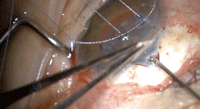Historically, trabeculectomy has been the gold standard in glaucoma surgery. The procedure has been indicated when medications and/or lasers fail to adequately control IOP; however, trabeculectomies also have been employed prior to laser therapy. Although considered the standard of care for uncontrolled glaucoma, trabeculectomy may not consistently provide optimal results and could place the patient at a higher risk of complications than other procedures.


The Express shunt (Alcon), a promising alternative surgical option, was actually more successful than trabeculectomy in controlling IOP without medication use for up to three years postop.1
The device creates a secure, uniform channel under the scleral flap, which enables aqueous drainage. The surgical technique entails the implantation of a shunt under a scleral flap to drain aqueous from the anterior chamber into the intrascleral space. After proper eye positioning and anesthesia, a conjunctival peritomy is fashioned superiorly and dissected back. The scleral bed is cauterized for hemostasis, followed by the creation of a triangular scleral flap with a base approximately 3mm in width.
Next, the scleral flap is brought forward into clear cornea. Using a Weck-Cel ophthalmic sponge (Beaver Visitec International), mitomycin-C is placed onto the scleral bed for approximately three minutes, removed, then irrigated with balanced salt solution (BSS). A 25-gauge needle is used to make a scleral tunnel incision into the anterior chamber parallel to the iris plane.
The Express shunt is then inserted and fashioned into this opening, flush with the sclera. Aqueous flow is tested for adequacy, then the flap is brought down and closed with three interrupted sutures that are tied and buried. BSS is instilled into the anterior chamber to evaluate outflow potential through the flap. Lastly, the conjunctiva is pulled forward and peritomy closed superiorly.
Multimedia

The surgeon creates a triangular scleral flap, beneath which the drainage shunt will be placed. Aqueous drains into the intrascleral space. Click
here to view a video of how this procedure is performed.
Candidacy for the Express shunt is similar to that for trabeculectomy: optic nerve or visual field progression despite maximum medical therapy and/or laser therapy; the inability to take drops adequately; moderate to advanced disease; and a low target pressure.
Clinical considerations for comanaging optometrists include an individualized discussion about laser and surgical options as well as both pre- and postoperative considerations. Patients must understand that while their current therapy may not have been successful, there are multiple options available to control their glaucoma. Let them know that you will be with them along the way to help address their condition. Communication with your surgeons regarding which glaucoma procedures they prefer to perform as well as the appropriate surgical indications for each option will help you make a proper referral.
1. De Jong, L, Lafuma, A. Aguade, AS, and Berdeaux, G. Five-year extension of a clinical trial comparing the EX-PRESS glaucoma filtration device and trabeculectomy in primary open-angle glaucoma. Clin Ophthalmol. 2011;5:527-533.

